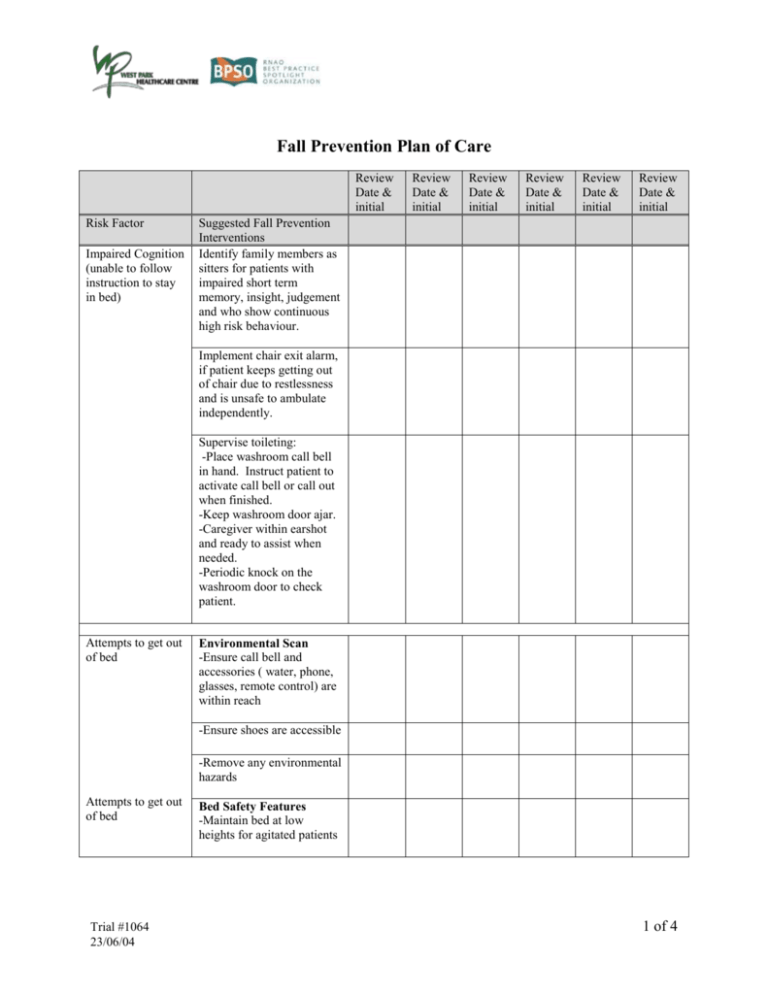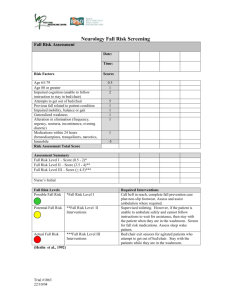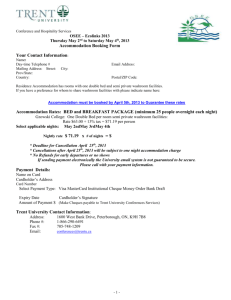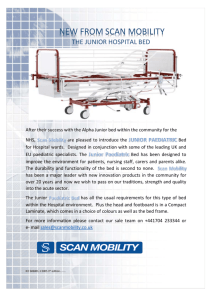West Park Healthcare Centre
advertisement

Fall Prevention Plan of Care Review Date & initial Risk Factor Impaired Cognition (unable to follow instruction to stay in bed) Review Date & initial Review Date & initial Review Date & initial Review Date & initial Review Date & initial Suggested Fall Prevention Interventions Identify family members as sitters for patients with impaired short term memory, insight, judgement and who show continuous high risk behaviour. Implement chair exit alarm, if patient keeps getting out of chair due to restlessness and is unsafe to ambulate independently. Supervise toileting: -Place washroom call bell in hand. Instruct patient to activate call bell or call out when finished. -Keep washroom door ajar. -Caregiver within earshot and ready to assist when needed. -Periodic knock on the washroom door to check patient. Attempts to get out of bed Environmental Scan -Ensure call bell and accessories ( water, phone, glasses, remote control) are within reach -Ensure shoes are accessible -Remove any environmental hazards Attempts to get out of bed Trial #1064 23/06/04 Bed Safety Features -Maintain bed at low heights for agitated patients 1 of 4 Review Date & initial Risk Factor Review Date & initial Review Date & initial Review Date & initial Review Date & initial Review Date & initial Suggested Fall Prevention Interventions -Bed rails up when they serve as effective psychological trigger to remind patient to stay in bed. -Additional mattress placed on floor beside bed for patients who demonstrate agitated, compulsive activity, but do not have the ability to stand up. -Bottom rails down for patients who repeatedly attempt to get out of bed and are able to stand up. -Additional mattress placed on floor beside bed. -Position beds at height for safe transfer. Previous falls related to risk factors Assess for vertigo Assess for orthostatic hypotension. If patient cognitively intact, teach patient how to rise to sit from supine, and how to rise to stand from sitting. If patient is cognitively impaired, assist patient with transfer. Impaired mobility Ensure proper footwear. Reinforce application of proper body mechanics in patients with impaired balance and gait. Reassess capacity for safe transfer daily. Trial #1064 23/06/04 2 of 4 Review Date & initial Risk Factor Review Date & initial Review Date & initial Review Date & initial Review Date & initial Review Date & initial Suggested Fall Prevention Interventions Only PT/OT to progress level of independence in transfer. For those who are cognitively intact, reinforce the type of transfer recommended by PT/OT. Transfer style and required level of assistance specified on communication board. Educate patients on all the steps to a safe transfer. Provide reminding and cueing regarding procedures for safe transfer and mobility. Generalized weakness Alterations in elimination Cue cards in patient room for: -Call nurse when needs assistance to go to washroom. -Put brakes on wheelchair before standing. -Hold onto grab bars. -Turn slowly to transfer onto toilet. -Call nurse for assistance if necessary. Practice prompted voiding for patients with incontinence. - Bladder management: - For patients on diuretics, be alerted to timing of voiding. - For patients with urinary tract infection, respond to urgency. - For patients with diagnosis of polyurea, increase frequency of support. Trial #1064 23/06/04 3 of 4 Review Date & initial Risk Factor Medications (Benzodiazepines, tranquilizers, narcotics, Review Date & initial Review Date & initial Review Date & initial Review Date & initial Review Date & initial Suggested Fall Prevention Interventions Collaborate with pharmacists to assess pharmaceutical use that may potentiate confusion, anxiety, agitation, hallucinations, delusions, dizziness, and drowsiness. Explore alternatives. Document sleep/rest response to medications and night-time behaviour. Establish sleep-rest cycle. Immobility Establish call bell priorization process Appoint a staff to respond Others as identified by the nurse Registered Nurses Association of Ontario (2002) Nursing Best Practice Guideline. Prevention of Falls and Fall Injuries in the Older Adult. Toronto, Canada. Trial #1064 23/06/04 4 of 4









